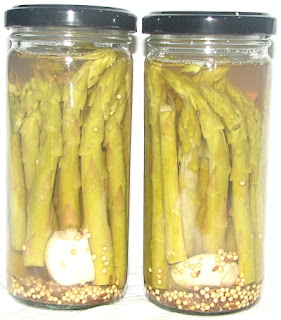
Vinegars are used in many preserving recipes, especially pickles, where the fruit or vegetable is packed into a vinegar solution (often with salt, sugar and/or water and spices added to the vinegar). It is important not to reduce the quantity of vinegar in a recipe - or increase the quantity of food and/or water in a recipe, as the acidity level may be reduced by doing so. Too little vinegar means the acidity level would be unsafe, whereas adding too much vinegar can alter the flavour of the final product greatly.
Vinegars of 5 percent acidity (50 grain) or more are recommended for water bath canning (and for the Fowlers Vacola method). Most recipes will state either white vinegar or cider vinegar. White vinegars are ideal for preserving light colours of fruits and vegetables (i.e. cauliflower), whereas cider vinegars (our preference) is more flavourful than white in our experience. You can substitute vinegars in recipes as long as the one you use is minimum 5% acidity - if you are unsure of the acidity level please check the label or enquire with the company before use.
Homemade vinegar is not recommended for canning, as the acidity level may not be constant or at 5% or more. If the acidity is not constant then the growth of botulinum bacteria could occur.
Red wine vinegar - fermented red wine, red colour. Also known as red grape vinegar. Usually 5-6% acidity.
White wine vinegar - fermented white wine, white or pale yellow colour. Also known as white grape vinegar. Usually 5-6% acidity.
Apple cider vinegar - fermented apple cider, yellow to golden colour. Usually 5-6% acidity. This is our favourite vinegar to pickle with.
Balsamic vinegar - certain types of white grapes are pressed into juice, then boiled down into a syrup and fermented, often aged 12-25 years before use. Has a dark red colour, with a rich, almost sweet flavour. Usually 5-6% acidity.
White balsamic vinegar - using the same pressed white grape juice as balsamic vinegar, but combined with white wine vinegar and then heated on a lower temperature to form the syrup, to stop the colour darkening. Used in place of balsamic vinegar where you don't want the colour of the preserves affected. Usually 5-6% acidity.
White vinegar - aslso known as distilled vinegar, white vinegar is fermented distilled alcohol. Usually 5-10% acidity.
Malt vinegar - made from malted barley, which is brewed into ale then fermented to make malt vinegar. Brown in colour and this is our family's favourite for adding on top of fish and chips! You can buy brown malt vinegar, spiced malt vinegar (ideal for pickling) and white malt vinegar. Usually 5-6% acidity.
USING 4% VINEGAR
When your vinegar is not 5%, and is lower i.e. 4% you will need to increase the quantity of vinegar in the recipe, and remove this difference in water (or other non-vinegar liquid in the recipe). If you cannot remove any water from the recipe, we do not recommend using 4% vinegar for pantry storage of preserves, as they may not be acidic enough to prevent spoilage.
i.e. 1 cup 5% vinegar = 1.25 cups 4% vinegar (and removing 0.25 cups of water)
USING 8% VINEGAR
USING 8% VINEGAR
When your vinegar is not 5%, and is higher i.e. 8%
instead of decreasing the quantity of vinegar in the recipe, we recommend mixing up a 5% vinegar using double strength vinegar plus water (water quantity is 60% of the vinegar quantity). Store this diluted vinegar in a labelled container (we reuse a vinegar bottle) including the type of vinegar and the percentage of acetic acid written clearly on the label. Use this vinegar as normal in the recipe.
i.e. 1 litre 8% vinegar + 0.6 litre water = 1.6 litres 5% vinegar
To check your percentage calculations are correct:
8% of 1 litre = 80ml (and 5% of 1.6 litres is also 80ml)
To check your percentage calculations are correct:
8% of 1 litre = 80ml (and 5% of 1.6 litres is also 80ml)
USING 10% VINEGAR
When your vinegar is not 5%, and is higher i.e. 10%
instead of decreasing the quantity of vinegar in the recipe, we
recommend mixing up a 5% vinegar using double strength vinegar plus
water (water quantity is same as the vinegar quantity). Store this
diluted vinegar in a labelled container (we recommend reusing a vinegar bottle)
including the type of vinegar and the percentage of acetic acid written
clearly on the label. Use this vinegar as normal in the recipe.
i.e. 1 litre 10% vinegar + 1 litre water = 2 litres 5% vinegar
To check your percentage calculations are correct:
10% of 1 litre = 100ml (and 5% of 2 litres is also 100ml)
To check your percentage calculations are correct:
10% of 1 litre = 100ml (and 5% of 2 litres is also 100ml)
Vinegar
for canning (water bath canning and/or Fowlers Vacola method) is minimum 5% acetic acid to ensure the pH of the completed preserve is
acidic enough to prevent spoilage during storage. Please check the vinegar packaging
prior to bottling to confirm the acetic acid content of the vinegar you
are using. If the label does not list the percentage, confirm with the company before use in your preserves.
Author: Megan Radaich
Image Credit: Megan Radaich
Publication: Preserve the Season: Pickling Guide, available HERE



